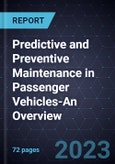Transformative Mega Trends in CASE Vehicles Fuel the Need for Integrated Preventive Maintenance
Passenger vehicle maintenance in Europe and North America has witnessed a transformative shift in the last decade from a traditional reactive approach to one that is proactive, focusing on predictive and preventive solutions. This shift can largely be attributed to the increased adoption of connectivity features in vehicles. Connected vehicles can transfer real-time vehicle data to diagnostic devices or a cloud platform for predicting component behavior, conducting failure analyses, and communicating corresponding insights back to the car or customer for maintenance or service action. The need for preventive maintenance solutions is underscored by their capacity to prevent critical failures, reduce vehicle downtime, enhance safety, and extend component lifetime. This study identifies the factors driving and restraining growth in this space. It also highlights the opportunities emerging from the changes in this industry for market players and stakeholders to leverage. The base year is 2022, and the forecast period is from 2023 to 2030.
Key Issues Addressed
- How has passenger vehicle preventive maintenance evolved over the years?
- What are the effects of prognostics? What are some of the use cases for stakeholders such as original equipment manufacturers (OEMs), tier suppliers, and solution providers?
- What solutions do different preventive maintenance providers offer? What are their business strategies?
- What are the growth opportunities available for prognostic solution providers? What are the strategies they must adopt?








